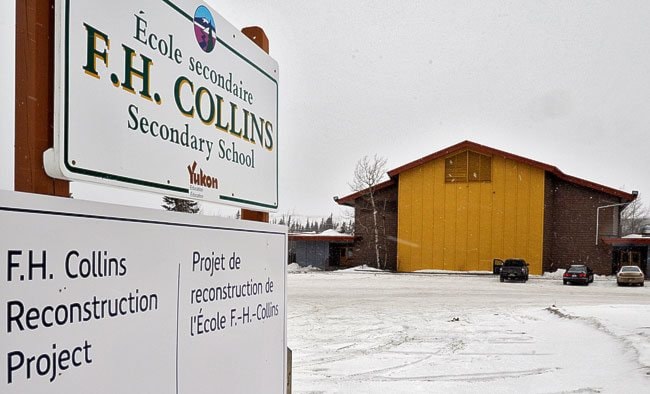The Yukon government fended off more questions about the F.H. Collins reconstruction project in the legislature this week, though not all of them were well researched.
The NDP peppered Education Minister Elaine Taylor and Public Works Minister Wade Istchenko with concerns that the new school is too small, and that the government will end up paying too much for it.
“Ten years and waiting,” said the NDP’s education critic, Jim Tredger. “The school we are buying off the shelf from Alberta is 2,500 square metres smaller than the previously tendered design. There are increasing concerns that Yukon Party’s latest redesign of the latest redesign of F.H. Collins will be inadequate to meet the curriculum and programming needs of students at F.H. Collins.”
The new school design is borrowed from Mother Margaret Mary Catholic High School in Terwilliger, Alberta.
Right now there are only about 430 students at the Alberta school, and 629 students enrolled at the current F.H. Collins, which Tredger said is proof that the government hasn’t planned well.
“We are now talking students - not sardines. There is a reason Mother Margaret Mary school has 430 students ... will this minister tell this House how a school that is modeled for 430 students will meet the needs of over 700 Yukon students and meet the education requirements of the 21st century?” Tredger asked.
But Tredger is wrong, as Education Minister Elaine Taylor pointed out.
Mother Margret Mary is designed for 750 students. It was built as part of a four-school expansion, not as a replacement for an existing building, according to the Alberta Department of Education. It was finished in 2012 and only has 450 students because it hasn’t reached its capacity yet.
The new F.H. Collins design also has a capacity of 750 students.
According to the Yukon Education Department, once the new school is finished, Whitehorse will have a recommended high school student capacity of 2,308 at F.H. Collins, Vanier Catholic and Porter Creek secondary schools. That’s still 758 spaces more than Whitehorse’s current student population.
In 2009, as part of the planning process for the new F.H. Collins, the department modelled the expected student growth as far out as 2020. When checked against its prediction for 2013, the model was only off by nine students.
The NDP also questioned the government’s budgeting practices for the new school.
In the spring, the government deep-sixed the original, Yukon-designed version of F.H. Collins after failing to include three major components in its approved budget. When bids, which included those components, came back over the management board-approved $38.6-million budget, the government decided to import the Alberta design instead.
The new design is an entirely different, much simpler school. It was built in 2012 in Alberta for $21 million. But as Premier Darrell Pasloski explained in the legislature, while planning for the Yukon version to be built here, the government chose not to re-evaluate the budget, and left it at $38.6 million.
“This is really quite amazing,” said NDP Leader Liz Hanson.
“The premier is standing here before this House - before the public and before the voters - and saying that, yes, spending the same amount of money - $38.6 million - for an off-the-shelf design and smaller school from Alberta is fiscally responsible.”
The NDP’s Louis Moorcroft accused the government of failing even to acquire a professional estimate for the new school’s cost. No one from the government side of the House disputed the point.
Instead, Public Works Minister Wade Istchenko accused Moorcroft of ignorance in government procedure.
“The member opposite is unable to distinguish and grasp how government functions. The contract has been put out - or tenderized to it. It’s the responsibility of the department officials with the expertise in those areas to make sure that this comes across,” Istchenko said.
Public Works spokeswoman Kendra Black explained that, unlike the original design, the government didn’t get separate professional estimates done. Instead, the project costs were evaluated by Barr Ryder Architects as part of its $900,000 contract as the bridging consultant on the project.
“Barr Ryder supplied the department with an order-of-magnitude cost estimate that is within the current estimated budget,” Black said, adding that the government hopes competitive bidding from contractors will keep the price close to the estimate.
Order-of-magnitude estimates are comparative, she said, based on the consultants’ own experience with similar projects, as well as current pricing.
Black would not say how close Barr Ryder’s estimate was to the $38.6-million mark for fear of compromising the tendering process.
Contact Jesse Winter at
jessew@yukon-news.com
